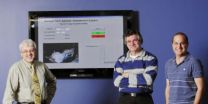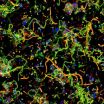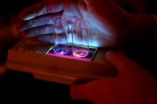(Press-News.org) Researchers at the Georgia Institute of Technology and the Northeast Georgia Medical Center are one step closer to their goal of automating the management of sedation in hospital intensive care units (ICUs). They have developed control algorithms that use clinical data to accurately determine a patient's level of sedation and can notify medical staff if there is a change in the level.
"ICU nurses have one of the most task-laden jobs in medicine and typically take care of multiple patients at the same time, so if we can use control system technology to automate the task of sedation, patient safety will be enhanced and drug delivery will improve in the ICU," said James Bailey, the chief medical informatics officer at the Northeast Georgia Medical Center in Gainesville, Ga. Bailey is also a certified anesthesiologist and intensive care specialist.
During a presentation at the IEEE Conference on Decision and Control, the researchers reported on their analysis of more than 15,000 clinical measurements from 366 ICU patients they classified as "agitated" or "not agitated." Agitation is a measure of the level of patient sedation. The algorithm returned the same results as the assessment by hospital staff 92 percent of the time.
"Manual sedation control can be tedious, imprecise, time-consuming and sometimes of poor quality, depending on the skills and judgment of the ICU nurse," said Wassim Haddad, a professor in the Georgia Tech School of Aerospace Engineering. "Ultimately, we envision an automated system in which the ICU nurse evaluates the ICU patient, enters the patient's sedation level into a controller, which then adjusts the sedative dosing regimen to maintain sedation at the desired level by continuously collecting and analyzing quantitative clinical data on the patient."
This project is supported in part by the U.S. Army. On the battlefield, military physicians sometimes face demanding critical care situations and the use of advanced control technologies is essential for extending the capabilities of the health care system to handle large numbers of injured soldiers.
Working with Haddad and Bailey on this project are Allen Tannenbaum and Behnood Gholami. Tannenbaum holds a joint appointment as the Julian Hightower Chair in the Georgia Tech School of Electrical and Computer Engineering and the Wallace H. Coulter Department of Biomedical Engineering at Georgia Tech and Emory University, while Gholami is currently a postdoctoral fellow in the Georgia Tech School of Electrical and Computer Engineering.
This research builds on Haddad and Bailey's previous work automating anesthesia in hospital operating rooms. The adaptive control algorithms developed by Haddad and Bailey control the infusion of an anesthetic drug agent in order to maintain a desired constant level of depth of anesthesia during surgery in the operating room. Clinical trial results that will be published in the March issue of the journal IEEE Transactions on Control Systems Technology demonstrate excellent regulation of unconsciousness allowing for a safe and effective administration of an anesthetic agent.
Critically ill patients in the ICU frequently require invasive monitoring and other support that can lead to anxiety, agitation and pain. Sedation is essential for the comfort and safety of these patients.
"The challenge in developing closed-loop control systems for sedating critically ill patients is finding the appropriate performance variable or variables that measure the level of sedation of a patient, in turn allowing an automated controller to provide adequate sedation without oversedation," said Gholami.
In the ICU, the researchers used information detailing each patient's facial expression, gross motor movement, response to a potentially noxious stimulus, heart rate and blood pressure stability, noncardiac sympathetic stability, and nonverbal pain scale to determine a level of sedation.
The researchers classified the clinical data for each variable into categories. For example, a patient's facial expression was categorized as "relaxed," "grimacing and moaning," or "grimacing and crying." A patient's noncardiac sympathetic stability was classified as "warm and dry skin," "flushed and sweaty," or "pale and sweaty."
They also recorded each patient's score on the motor activity and assessment scale (MAAS), which is used by clinicians to evaluate level of sedation on a scale of zero to six. In the MAAS system, a score of zero represents an "unresponsive patient," three represents a "calm and cooperative patient," and six represents a "dangerously agitated patient." The MAAS score is subjective and can result in inconsistencies and variability in sedation administration.
Using a Bayesian network, the researchers used the clinical data to compute the probability that a patient was agitated. Twelve-thousand measurements collected from patients admitted to the ICU at the Northeast Georgia Medical Center between during a one-year period were used to train the Bayesian network and the remaining 3,000 were used to test it.
In 18 percent of the test cases, the computer classified a patient as "agitated" but the MAAS score described the same patient as "not agitated." In five percent of the test cases, the computer classified a patient as "not agitated," whereas the MAAS score indicated "agitated." These probabilities signify an 18 percent false-positive rate and a five percent false-negative rate.
"This level of performance would allow a significant reduction in the workload of the intensive care unit nurse, but it would in no way replace the nurse as the ultimate judge of the adequacy of sedation," said Bailey. "However, by relieving the nurse of some of the work associated with titration of sedation, it would allow the nurse to better focus on other aspects of his or her demanding job."
The researchers' next step toward closed-loop control of sedation in the ICU will be to continuously collect clinical data from ICU patients in real time. Future work will involve the development of objective techniques for assessing ICU sedation using movement, facial expression and responsiveness to stimuli.
Digital imaging will be used to assess a patient's facial expression and also gross motor movement. In a study published in the June 2010 issue of the journal IEEE Transactions on Biomedical Engineering, the researchers showed that machine learning methods could be used to assess the level of pain in patients using facial expressions.
"We will explore the relationship between the data we can extract from these multiple sensors and the subjective clinical MAAS score," said Haddad. "We will then use the knowledge we have gained in developing feedback control algorithms for anesthesia dosage levels in the operating room to develop an expert system to automate drug dosage in the ICU."
INFORMATION:
This project is supported in part by the U.S. Army Medical Research and Material Command (Grant No. 08108002). The content is solely the responsibility of the principal investigator (Wassim Haddad) and does not necessarily represent the official views of the U.S. Army.
Researchers working toward automating sedation in intensive care units
Computer system for evaluating sedation level shows strong agreement with clinical assessment
2011-02-15
ELSE PRESS RELEASES FROM THIS DATE:
Quest for designer bacteria uncovers a 'Spy'
2011-02-15
ANN ARBOR, Mich.---Scientists have discovered a molecular assistant called Spy that helps bacteria excel at producing proteins for medical and industrial purposes.
Bacteria are widely used to manufacture proteins used in medicine and industry, but the bugs often bungle the job. Many proteins fall apart and get cut up inside the bacteria before they can be harvested. Others collapse into useless tangles instead of folding properly, as they must in order to function normally.
A research team led by James Bardwell, who is a professor of molecular, cellular and developmental ...
New scholarly paper reveals 100 new species of lichenized fungi
2011-02-15
CHICAGO, IL – In an unprecedented coming-out party, 100 newly discovered species are revealed to the world in a single scholarly paper coordinated by Field Museum scientists.
The 100 organisms are lichens, a type of fungi that form associations with algae and populate environments from arctic tundra to tropical rain forests. And the usual inattention bestowed upon new lichens is one reason for aggregating so many new ones in a single paper in the Feb. 18 issue of the journal Phytotaxa.
It is estimated that about 100,000 fungal species, including 17,500 lichens, have been ...
Choosing your neighbors: MBL scientists see how microbes relate in space
2011-02-15
MBL, WOODS HOLE, MA—Like people in cities, microbes often live in complex communities that contain many different microbial types. Also like us, microbes tend to gravitate to and "hang out" with certain other types in their community, more than with the rest. And sometimes, when opportunities arise, they move to more favorable locations.
But until recently, scientists have not been able to look at a microbial community and distinguish the spatial relationship of more than 2 or 3 kinds of microbes at once.
Now, a microscopy technique developed at the Marine Biological ...
Jewel-toned organic phosphorescent crystals: A new class of light-emitting material
2011-02-15
ANN ARBOR, Mich.---Pure organic compounds that glow in jewel tones could potentially lead to cheaper, more efficient and flexible display screens, among other applications.
University of Michigan researcher Jinsang Kim and his colleagues have developed a new class of material that shines with phosphorescence---a property that has previously been seen only in non-organic compounds or organometallics.
Kim and his colleagues made metal-free organic crystals that are white in visible light and radiate blue, green, yellow and orange when triggered by ultraviolet light. ...
Treating the aging knee as an organ
2011-02-15
DETROIT – The human body is made up of several organs composed of tissues that enable them to perform a particular function. The heart circulates blood; the brain is the micro-neuro center of the body; the lungs bring in oxygen and release carbon dioxide.
The failure of any one of these tissue systems can cause serious health issues, even death. When components of the organ are fixed, typically the organ functions better. For instance, unclogging a blocked artery with a balloon stent improves blood circulation to and from the heart.
Henry Ford Hospital researcher Fred ...
Does social anxiety disorder respond to psychotherapy? Brain study says yes
2011-02-15
When psychotherapy is helping someone get better, what does that change look like in the brain? This was the question a team of Canadian psychological scientists set out to investigate in patients suffering from social anxiety disorder. Their findings are published in Psychological Science, a journal of the Association of Psychological Science.
Social anxiety is a common disorder, marked by overwhelming fears of interacting with others and expectations of being harshly judged. Medication and psychotherapy both help people with the disorder. But research on the neurological ...
UCLA Engineering advance with new nanomaterials good news for next-generation electronic devices
2011-02-15
In recent years, topological insulators have become one of the hottest topics in physics. These new materials act as both insulators and conductors, with their interior preventing the flow of electrical currents while their edges or surfaces allow the movement of a charge.
Perhaps most importantly, the surfaces of topological insulators enable the transport of spin-polarized electrons while preventing the "scattering" typically associated with power consumption, in which electrons deviate from their trajectory, resulting in dissipation.
Because of such characteristics, ...
Physicists isolate bound states in graphene-superconductor junctions
2011-02-15
CHAMPAIGN, Ill. — Illinois researchers have documented the first observations of some unusual physics when two prominent electric materials are connected: superconductors and graphene.
Led by University of Illinois physics professor Nadya Mason, the group published its findings in the journal Nature Physics.
When a current is applied to a normal conductor, such as metal or graphene, it flows through the material as a stream of single electrons. By contrast, electrons travel in pairs in superconductors. Yet when a normal material is sandwiched between superconductors, ...
Psychology students to present on cheaper textbook alternatives at national conference
2011-02-15
A group of University of Cincinnati seniors in the psychology program will nationally present their comparison of educational technology alternatives to purchasing college textbooks that can run into hundreds of dollars per academic quarter. Their research as part of the statewide Ohio Digital Bookshelf Project will be presented on Monday, Feb. 14, at the national EDUCAUSE Annual Meeting in Washington, DC.
The Digital Bookshelf Project is an initiative under the University System of Ohio (USO) Strategic Plan for Higher Education to develop a high-quality, affordable, ...
Gene that regulates immune system linked to preeclampsia
2011-02-15
Researchers at North Carolina State University have discovered that the placentas of women who suffer preeclampsia during pregnancy have an overabundance of a gene associated with the regulation of the body's immune system. Their discovery may lead to improved screening and prenatal care for these patients and their babies.
Preeclampsia occurs in up to 10 percent of all pregnancies, and is responsible for about 15 percent of pre-term births. The disorder is usually marked by a rapid rise in blood pressure that can lead to stroke, seizures or organ failures in the mother. ...
LAST 30 PRESS RELEASES:
Why nail-biting, procrastination and other self-sabotaging behaviors are rooted in survival instincts
Regional variations in mechanical properties of porcine leptomeninges
Artificial empathy in therapy and healthcare: advancements in interpersonal interaction technologies
Why some brains switch gears more efficiently than others
UVA’s Jundong Li wins ICDM’S 2025 Tao Li Award for data mining, machine learning
UVA’s low-power, high-performance computer power player Mircea Stan earns National Academy of Inventors fellowship
Not playing by the rules: USU researcher explores filamentous algae dynamics in rivers
Do our body clocks influence our risk of dementia?
Anthropologists offer new evidence of bipedalism in long-debated fossil discovery
Safer receipt paper from wood
Dosage-sensitive genes suggest no whole-genome duplications in ancestral angiosperm
First ancient human herpesvirus genomes document their deep history with humans
Why Some Bacteria Survive Antibiotics and How to Stop Them - New study reveals that bacteria can survive antibiotic treatment through two fundamentally different “shutdown modes”
UCLA study links scar healing to dangerous placenta condition
CHANGE-seq-BE finds off-target changes in the genome from base editors
The Journal of Nuclear Medicine Ahead-of-Print Tip Sheet: January 2, 2026
Delayed or absent first dose of measles, mumps, and rubella vaccination
Trends in US preterm birth rates by household income and race and ethnicity
Study identifies potential biomarker linked to progression and brain inflammation in multiple sclerosis
Many mothers in Norway do not show up for postnatal check-ups
Researchers want to find out why quick clay is so unstable
Superradiant spins show teamwork at the quantum scale
Cleveland Clinic Research links tumor bacteria to immunotherapy resistance in head and neck cancer
First Editorial of 2026: Resisting AI slop
Joint ground- and space-based observations reveal Saturn-mass rogue planet
Inheritable genetic variant offers protection against blood cancer risk and progression
Pigs settled Pacific islands alongside early human voyagers
A Coral reef’s daily pulse reshapes microbes in surrounding waters
EAST Tokamak experiments exceed plasma density limit, offering new approach to fusion ignition
Groundbreaking discovery reveals Africa’s oldest cremation pyre and complex ritual practices
[Press-News.org] Researchers working toward automating sedation in intensive care unitsComputer system for evaluating sedation level shows strong agreement with clinical assessment



